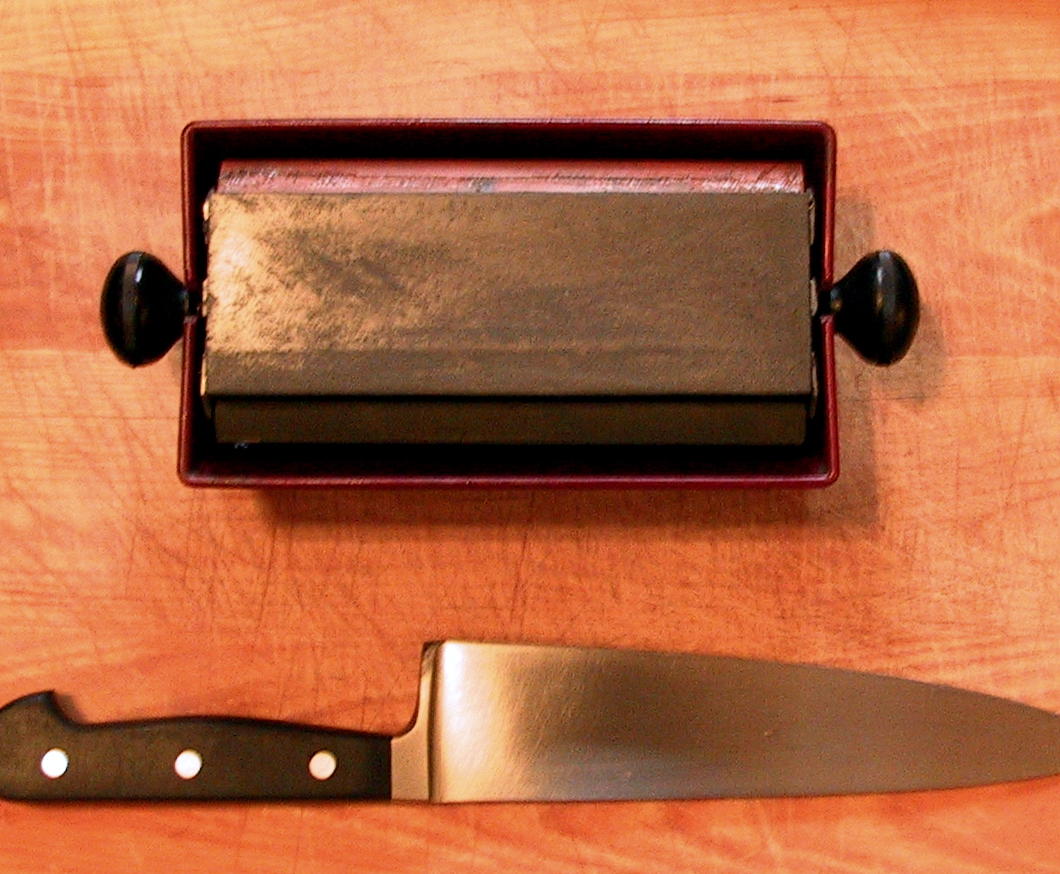Maintaining Your Knives
Touch a brand-new blade gently with your thumb and it should feel very sharp. As you use it, though, it will naturally grow duller over time. There are two tools that you need to maintain the quality of the blade so that your knife will continue to serve you well: a honing steel and a sharpener. A common myth is that a steel sharpens the blade; actually, it maintains the blade so that it is straight and true. Properly used, it will help keep your blade sharper, longer; used improperly it will dull the blade.


To use the steel correctly, grasp it in your guide hand and hold your knife in your dominant hand. Next, find the appropriate angle between your blade and the steel, about 20 degrees. The snooty-snoo guy at the knife counter in the upscale kitchen store will advise you that the exact angle desired is 22.5 degrees; but, in all reality, as long as you’re in the right ballpark, you’ll be doing your knife more good than harm. His guideline can be helpful, though, especially since his angle might be even easier to find than the ballpark figure: hold it at a 45 degree angle, and then cut the angle in half. You’ll be right where you want to be. Starting with the heel of the blade (the end closer to the handle), turn your wrist so that you scrape the blade evenly across the steel in one fluid motion. Repeat for the other side of the blade. Get each side of the blade 4-6 times, but not more than that: over-honing your blade will dull it prematurely. Most new steels have a shield at the top of the handle to protect you from accidentally slashing your thumb while honing the blade. Make sure you keep your thumb behind this shield, because if you’re not paying attention, it’s easy to give yourself a healthy laceration. If your steel happens to be an older model without a shield, make sure you watch where your hand is and make certain that it’s well out of harm’s way.
Even if you use your steel appropriately, there will come a time when you need to sharpen your knife. I like to use a three-sided sharpening stone because it gives me maximum control over how the blades are sharpened.

To use it, I hold the blade to the stone at the same angle I hone it (~22.5 degrees), and press down evenly while I run the blade across the stone. The stone grinds away the metal, leaving a new edge. The results are great, but truth be told, it’s the sort of tool that anyone who’s not a pro would have a hard time using. For most people, it makes more sense to get a tool to do the job for you.
Because I don’t use automatic sharpeners, I can’t offer a personal recommendation; but, the November/December 2006 issue of Cook’s Illustrated summarizes a test of a dozen different manual sharpeners and they recommend three brands: AccuSharp Knife and Tool Sharpener, Anolon Universal Knife Sharpener, and Chantry Knife Sharpener. They always test products thoroughly, so I trust their word on the matter. Even though they say the manual sharpeners do the job, they conclude the article by stating that “in the long run, an electric sharpener is a good investment, if you can make the initial cash outlay,” which can be substantial. The model of electric sharpeners that they recommend, the Chef’s Choice 120 or 130, retails, according to them, for about $130 and $140, respectively. The manual models, on the other hand, sell for $12-$40.
Generally, you’ll want to sharpen your knives every 3-4 months under normal usage patterns, or whenever you notice that honing your knife doesn’t bring your blade back to where it ought to be. It may be tough to justify spending so much on a piece of equipment that will be used so infrequently, but on the other hand, the electric sharpening model can likely be expected to last at least eight times as long as a hand-held model. Not only that, but you may need to use it more frequently when you’re first learning to find the correct angle at which to hone your blade. My recommendation would be to wait a few months after buying your knives before you invest in a sharpener. With any luck, you’ll have a birthday or some other gift-giving holiday in the interim and you’ll be able to get someone else to buy the sharpener for you.
One final note: whenever you sharpen your knife, wipe the blade down with a damp towel and then hone it immediately. Doing so makes your sharp knife seem even sharper and keeps the stray bits of metal inevitably left on your blade (even after wiping it down) from winding up in your diet.
Photo Credits: Aurora Sharrard
December 5th, 2006 at 6:32 pm
[...] Maintaining Your Blade: Over time, your blade will grow dull. Here’s what you need to know to make sure that it constantly stays sharp. [...]
August 22nd, 2008 at 12:23 pm
You wrote, “A common myth is that a steel sharpens the blade; actually, it maintains the blade so that it is straight and true. Properly used, it will help keep your blade sharper, longer; used improperly it will dull the blade.”
So my question is why most people suggest using a steel by pushing the blade down the steel. If the objective is to straighten, rather than sharpen, shouldn’t the motion be the opposite? That is, pulling the blade up the steel, with the edge on the steel.